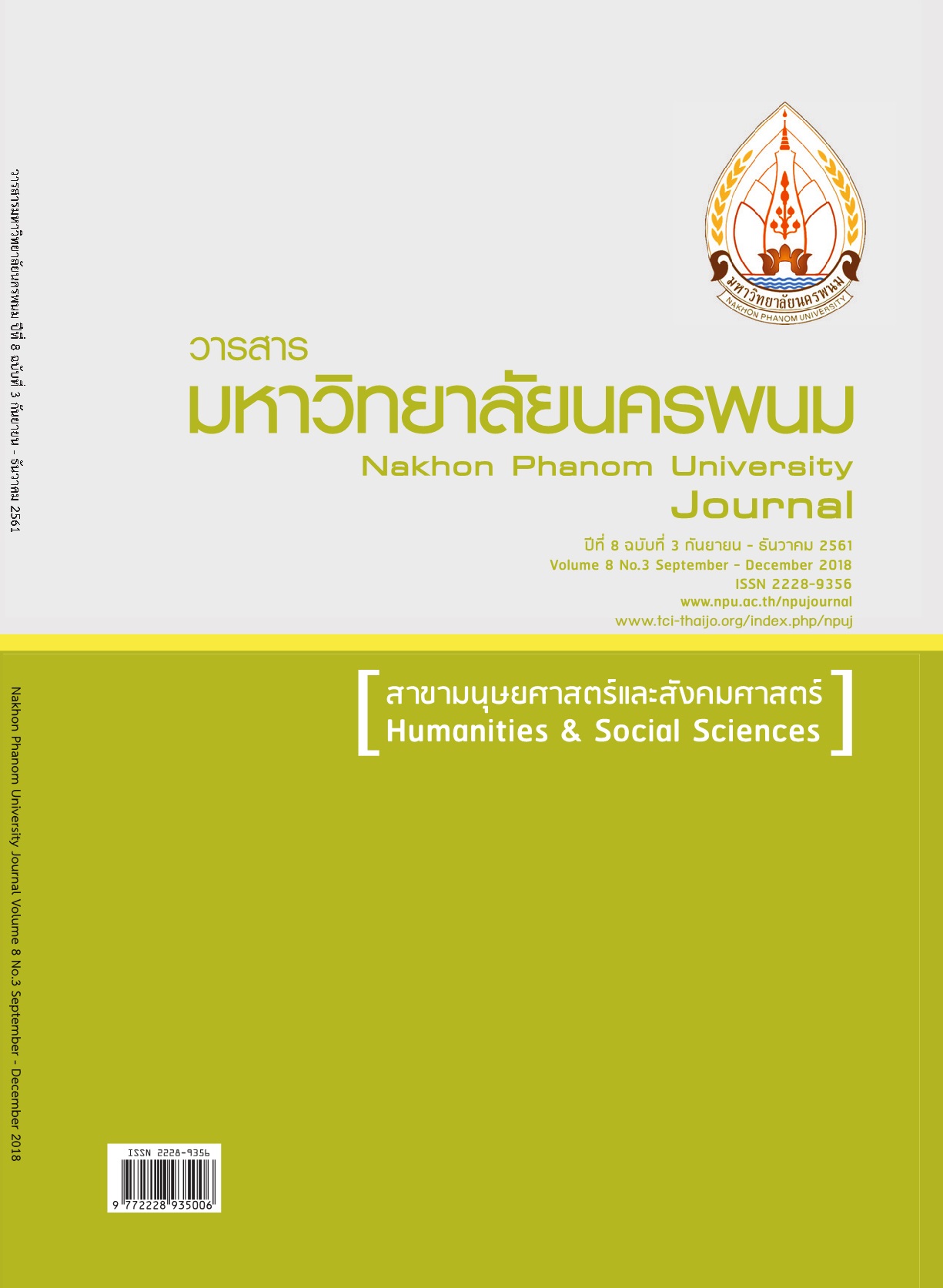Strategy to Develop Analytical Thinking Skills of the Eleventh Grade Students of the World Class Schools in Ubon Ratchathani Province
Main Article Content
Abstract
The objectives of the research were to study the critical thinking potential of Mattayomsueksa
5 students of the World Class Standard schools in Ubon Ratchathani province, to create and experiment
the strategies, and to evaluate the strategies. The population used in the first phase was 340 Mattayomsueksa 5 students whose size was determined by Krejcie and Morgan’s criterion. In the
second phase, the research was divided into three steps. 1) An analysis of internal and external conditions:
the target group numbered 30 that was specifically selected. 2) A total of 13 expertsparticipated in focus
group. 3) Experimental use of the strategies: the target was 30 students specifically selected In the third
phase concerning an evaluation of a possibility and suitability of the strategies, 20 experts were employed.
The research instruments were a questionnaire having a congruence index value equivalent to 0.8-1.0 and
a confidence value equivalent to 0.85, a SWOT Analysis, a satisfaction evaluation form, an evaluation
form on suitability and possibility of the strategies. Statistics used were mean, standard deviation, SWOT
TOWS Matrix and content analysis.
The research found that: (1) The critical thinking potential of Mattayomsueksa 5 students of
the World Class Standard schools in Ubon Ratchathani province was moderate averaging 3.37. (2) Creation
and use of the strategies: the analysis of external and internal conditions showed that the strength was
equivalent to 3.99 and weakness was equivalent to 4.30, opportunity was equivalent to 4.22, and an obstacle was equivalent to 3.32. The four strategies consisted of 16 tactics, 45 measures and 45 indicators. The four strategies were as follows; 1). Support for World Class Standard schools in developing
the critical thinking potential of learners; 2) improvement of the potential of learners of the standardized
schools; 3) development of supportive factors in education to increase the critical thinking potential of
learners; 4) promotion of the cooperation between the networks to drive the development of the critical thinking potential. The use of strategy 2, tactic 2.2 showed that students were satisfied with independent learning activities in three aspects. It averaged 3.80. (3) An evaluation of the strategies under study found that vision was found to be suitable and possible at a high level; mission was suitable at the highest level; the possibility was at a high level. The objectives were suitable and possible at a high level. Strategy 1,2,3,4 was suitable and possible at a high level.
Article Details
References
เกรียงศักดิ์ เจริญวงศ์ศักดิ์. (2558). “การสอนให้นักศึกษาเป็นนักคิดวิเคราะห์ สังเคราะห์และวิพากย์.” เอกสารการบรรยาย จัดโดยมหาวิทยาลัยเทคโนโลยีสุรนารี ณ โรงแรมเดอะวินเทจ โฮเทล เขาใหญ่ วันศุกร์ที่ 4 กันยายน พ.ศ.2558
จารุวรรณ พลอยดวงรัตน์และกัลยารัตน์ เมธีวีรวงศ์. (2558). “บทความวิชาการเรื่อง การบริหารจัดการโรงเรียนมาตรฐานสากลสู่ความเป็นเลิศ Word Class Standard School to be the best”.(ออนไลน์) สืบค้นเมื่อธันวาคม2560 จาก https://ejournals.swu.ac.th/index.php/EAJ/article/viewFile/5398/5069
จินตนา ธนวิบูลย์ชัย. (2559). “หน่วยที่ 11 การคิด การคิดแก้ปัญหาและการตัดสินใจ”. ใน ประมวลสาระชุดวิชาจิตวิทยาเพื่อการดำรงชีวิต. พิมพ์ครั้งที่ 8. นนทบุรี สำนักพิมพ์มหาวิทยาลัยสุโขทัยธรรมาธิราช.
ชลิดา เหลี่ยมวิเศษ. (2559). “การคิดเชิงวิเคราะห์ : เครื่องมือสำหรับผู้เรียนในศตวรรษที่ 21”. (ออนไลน์) สืบค้นเมื่อธันวาคม2560 จาก https://sasuphan.dusit.ac.th/index.php/group/research/artical-research
บุญชม ศรีสะอาด. (2556). วิธีการทางสถิติสำหรับการวิจัย เล่มที่ 1.(พิมพ์ครั้งที่ 5).กรุงเทพฯ : สุวีริยาสาสน์.
พสุ เดชะรินทร์. (2558). “การวางแผนเชิงยุทธศาสตร์”.”บทความเผยแพร่ กรมการค้าภายใน, (ออนไลน์) สืบค้นเมื่อ กรกฎาคม 2560) จาก https://www.dit.go.th/download.phpref.
พีร์ พงศ์พิพัฒนพันธ์. (2560). สัมฤทธิผลการศึกษาแบบไทยๆ. (ออนไลน์) สืบค้นเมื่อ มกราคม 2561 จาก https://prachatai.com/journal/2017/01/69688
เมตต์ เมตต์การุณ์จิต. (2556). ยุทธศาสตร์การพัฒนา : จากทฤษฎีสู่การปฏิบัติเชิงรุก. นนทบุรี : บุ๊คพอยท์.
สำนักงานเขตพื้นที่การศึกษามัธยมศึกษาเขต 29. (2560). ข้อมูลนักเรียนโรงเรียนมาตรฐานสากล จังหวัดอุบลราชธานี. (ออนไลน์) สืบค้นเมื่อ มิถุนายน 2560 จาก https://www.secondary29.go.th/
สำนักงานเลขาธิการสภาการศึกษา กระทรวงศึกษาธิการ. (2560). แผนการศึกษาแห่งชาติ (พ.ศ.2560 – 2574). กรุงเทพฯ : บริษัท พริกหวานกราฟิค จำกัด.
Krejcie, R.V., & Morgan, D.W. (1970).Determining sample size for research activities.Journal of Educational and Psychological Measurement, 30(3); 607-610).


